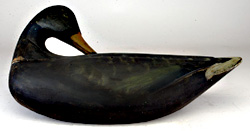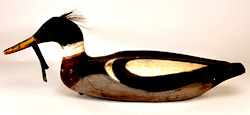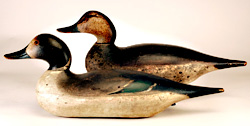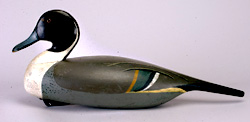When Does a Decoy Wood Carving Rise
to the Level of Folk Art?
By James David Brodell, M.D.
Exactly how many antique wood decoy carvings are being actively used as hunting lures, or are sitting on fireplace mantels as part of expanding collections, or are lying in attics collecting dust, would be anyone's guess. Also, the quality of craftsmanship, scarcity, reputation of the carver, amount of past wear and tear, and restoration, can all have a profound effect on any given piece's financial valuation. Amidst this uncertainty, an even greater nagging question often sits and festers in the mind of the serious student of decoy collecting: When does a decoy rise above the level of a mere old hunting device to be considered true American folk art? |

|
Not infrequently, expert dealers will advertise a given decoy as "folky," or having "folk appeal," or being "an outstanding example of folk art." Many of us see it, and feel it, but exactly what is being visualized and experienced? |
The term "folk," as in "jist a bunch of us folks gettin' together fer dinner," implies that an artistic work was handmade by, and should be of interest to, the common man. Modern power tool carving techniques, which provide minute detail, and hyper-realistic, sophisticated methods of paint application, are absent. Thus, photographic-type reproductions of wildlife, decorative renderings if you will, which appear so real you have to look twice to make sure the live bird isn't in the room with you, don't qualify as folk art. |

|

|
Mass-produced birds, such as those generated by the celebrated Mason Decoy Factory, are highly collectible for their wonderful carving and paint application, not to mention their exceedingly important place in American decoy lore. Beautiful and functional floating lures, they are, most assuredly, not folk art. |
For a decoy to possess folk character, then, traditional carving techniques and the most basic materials, will have been utilized. An American maker, likely a crackerjack hunter, effusive character, and animated story-teller, renders the rough, indispensable components of form and function with a flowing, sleek, carving style. Minimalist, rudimentary paint application with muted tones, often segmented with basic geometric shapes, allows for visualization of the most fundamental, intrinsic elements of surface anatomy only. Absent any true-to-life representation, what is visualized has a distinctly abstract quality. |

|

|
This "primitive" methodology combines to make for a whole that is much greater than its parts. The interpretative presence of the artist is experienced as the piece becomes more than a mere structural form. Indeed, a folky decoy engenders a special light, charming, somewhat bemusing, emotional effect; an understanding of the essence of a fellow creature -- its spirit or personality. |
"Stripped" to the core of its living essence, an old folk art lure can be held and caressed ... the grain of the wood, absent modern primers, feels as it was one hundred years ago. Emanating from within, such a decoy conjures up an awareness of a simpler time long ago, the essential goodness of the human spirt, the joy of the American experience, and man's reverence for nature. |

|

|
If a painted wooden sculpture of wildlife succeeds in achieving this level of emotional response, something which happens almost instantaneously upon viewing and holding, then the carver/painter has accomplished something far greater than the production of a hunting lure. The maker has dreamed, interpreted, created, and gifted subliminal impressions of shape, movement, and inner feelings. To be enjoyed by generations to come, such works ascend to the level of folk art having, interestingly enough, wide appeal to Americans of all walks of life. |
Folk art, then, is an elevation of experience. It provides an opportunity for us to see and feel things we may have taken for granted. So, the next time you pick up a decoy, take a close look and a gentle touch. If it "touches" you in return, you're holding American folk art. Never let go. |
Dr. Brodell is a collector of contemporary and antique decoys. He has been a
curator for, and sits on the board of, the Butler Institute of American Art,
Youngstown, Ohio.
|
|